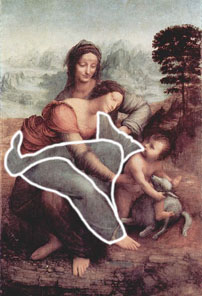Leonardo da Vinci, A Memory of His Childhood, 1910, by Sigmund Freud
Leonardo da Vinci and A Memory of His Childhood is a 1910 essay by Sigmund Freud about the childhood of Leonardo da Vinci. It consists of a psychoanalytic study of Leonardo's life based on his paintings.
Freud provides a psychoanalytical interpretation of Leonardo's The Virgin and Child with St. Anne. According to Oskar Pfister, the Virgin's garment reveals a vulture when viewed sideways. Freud accepted this interpretation (in spite of the outlines resembling rather a duck than a vulture) as a supportive interpretation of his view of a "passive homosexual" childhood fantasy Leonardo wrote about in the Codex Atlanticus. Here, Leonardo recounts being attacked as an infant in his crib by the tail of a vulture. Freud translated the passage thus:
It seems that it had been destined before that I should occupy myself so thoroughly with the vulture, for it comes to my mind as a very early memory, when I was still in the cradle, a vulture came down to me, he opened my mouth with his tail and struck me a few times with his tail against my lips.

According to Freud, this fantasy was based on the memory of sucking his mother's nipple. He backed up his claim with the fact that Egyptian hieroglyphs represent the mother as a vulture, because the Egyptians believed that there are no male vultures and that the females of the species are impregnated by the wind.
Unfortunately, the translation "Geier" (vulture), which Maria Herzfeld had used for "nibio" in 1904 in the first edition of her book Leonardo da Vinci, der Denker, Forscher und Poet, was not exactly the kite Leonardo da Vinci had meant: a small hawk-like bird of prey, common in the Vinci area, which is occasionally a scavenger. This disappointed Freud because, as he confessed to Lou Andreas-Salome in a letter of 9 February 1919, he regarded the Leonardo essay as "the only beautiful thing I have ever written". Some Freudian scholars have, however, made attempts to repair the theory by incorporating the kite.
Another theory proposed by Freud attempts to explain Leonardo's fondness of depicting the Virgin Mary with St. Anne. Leonardo, who was illegitimate, was raised by his blood mother initially before being "adopted" by the wife of his father Ser Piero. The idea of depicting the Mother of God with her own mother was therefore particularly close to Leonardo's heart, because he, in a sense, had 'two mothers' himself. It is worth noting that in both versions of the composition (the Louvre painting and the London cartoon) it is hard to discern whether St. Anne is a full generation older than Mary.
